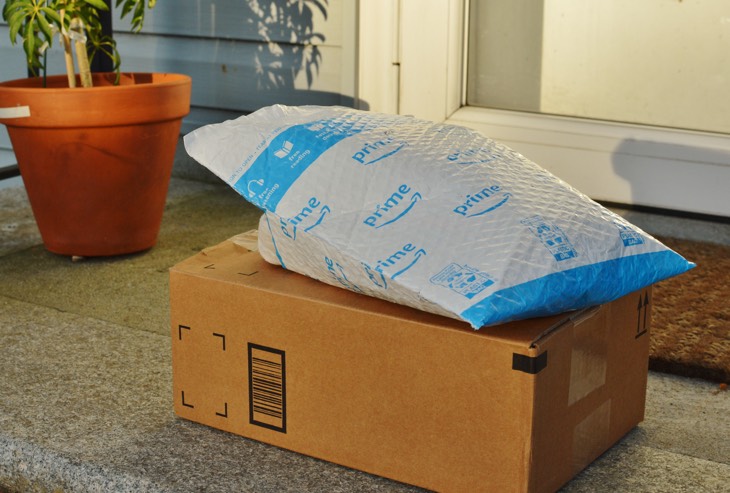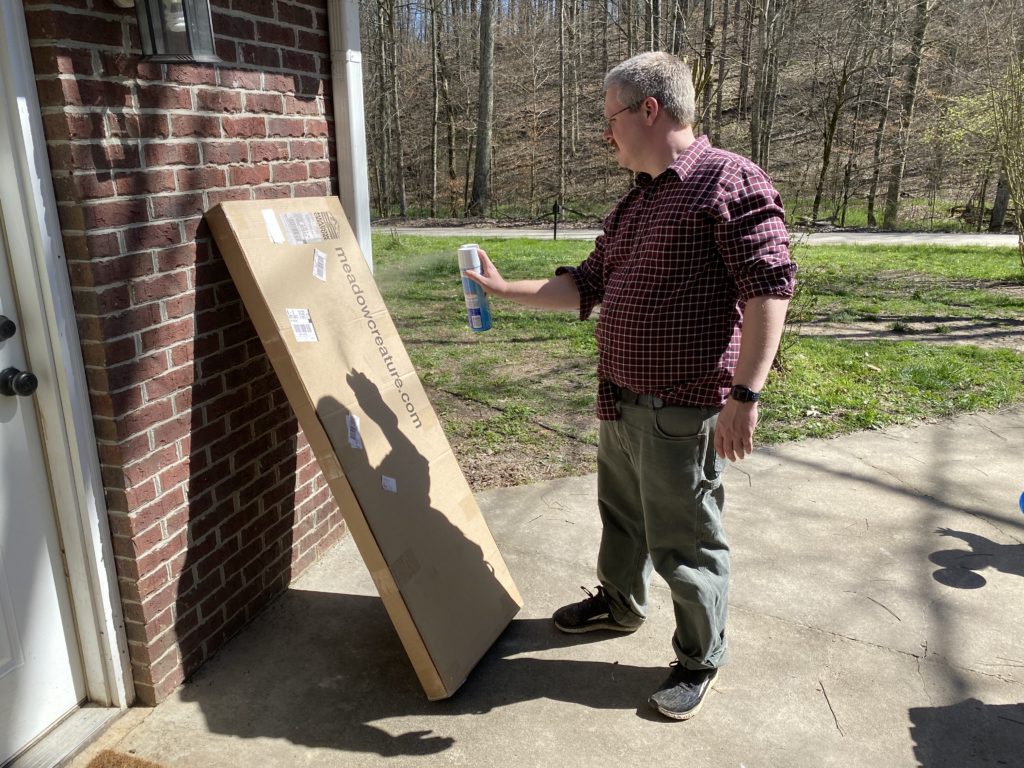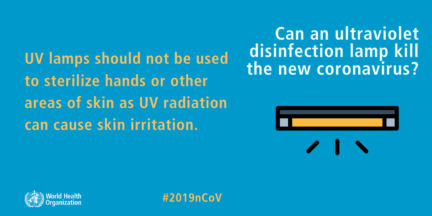If you’re one of the tens of millions of Americans under home quarantine, then you’ve probably turned to online retail for making purchases of everything from basic food staples to home-school supplies. But evidence is increasingly pointing toward the possibility that coronavirus spreads more via contact with contaminated surfaces than it does through the air, which means making online purchases isn’t a surefire way to avoid exposing yourself to potential infection.
Update: Fact-checking the CDC’s new guidance: you should still disinfect packages
Here’s what you need to know:
- Avoid the delivery person. If the option is available, choose a “no contact” delivery.
- Treat the package as a biohazard, which means taking precautions if you have to touch it (gloves, washing hands, etc.)
- It’s safest and cheapest to wait at least five days before handling or opening the package. While the virus dies off on cardboard in about 24 hours, it lives much longer on other materials. If the warehouse worker who packed the item or delivery person who dropped it off was infected, then there could be virus present not only on the cardboard or paper of the package, but on any plastic tape, labels, or inside the packaging.
- If you choose to disinfect instead of waiting it out, use a cleaner from the EPA’s approved list.
- You can use ultraviolet light to disinfect, but it’s complicated, expensive, and hard to recommend.
Sizing up the threats
The first threat of coronavirus infection comes from the delivery person, who will often still walk right up to you and hand you the package if you’re standing outside. Whenever I see a delivery truck pull up I run in the house if I’m out in my yard. That makes me feel a little like Dale from King of the Hill, but better safe than sorry.
The second threat is the package itself. The New England Journal of Medicine reports that SARS-CoV-2 can survive on cardboard for up to 24 hours and plastic and stainless steel for up to 72 hours. WebMD reports that coronavirus can survive on wood for up to four days and on ceramics, glass, paper, and non-stainless metals for up to five days. So you need to treat every package that arrives at your doorstep as a threat. There have already been Amazon warehouse workers who have tested positive for the virus who could be contaminating packages.

The third threat is the contents of the package. As I mentioned above, the virus can live on surfaces for up to five days. As far as we know, this is as long as the virus can survive, so after being rude and unsociable to your poor delivery driver, the next precaution you want to take is to wait at least five days before opening any packages.
The first threat is the easiest to deal with, but the third is also pretty easy to handle via this time-saving hack:
If you’re in a hurry to open your package, you could decontaminate the outside of the box using one of the aforementioned methods, and then retrieve the contents after waiting five days from the time the order was dropped off at the carrier for shipping. You can figure out when your package was definitely sealed up for shipping (and its contents shielded from further contamination) by looking up the tracking number with the carrier. Understand that tracking starts when a label is generated, not necessarily when the product is boxed up. So when calculating the time, you want to start with an entry like “package has left the carrier facility,” because then you know for sure that the item was boxed up by then.
As for dealing with possible contamination of the packaging box (the third threat, above), that’s the trickiest. Here are some possible solutions:
Leave the box on the porch and wait
The cheapest method for disinfecting your deliveries is to let the box sit untouched for at least five days to let any virus that may be on the box die off. If SARS-CoV-2 only lives 24 hours on cardboard, why wait the full five days? Because parcels aren’t just cardboard, there is almost certainly tape and plastic-containing labels on the outside. Giving the box a full five days before touching it minimizes your risk as much as possible.
If you have a well-covered porch in a low-crime neighborhood, you might let boxes sit for a few days. But this isn’t a foolproof method.
It’s been raining hard at my house, so any package would be soaked by the time the five-day period was up. Also, I have small children, and trying to get them to not touch a mystery box is impossible. And what if another package is placed on the first package? You’ll have to double the quarantine time and hope the stack doesn’t grow.
Quarantine the box in a dedicated area
An upgraded version of the “wait it out” method is to have a special area set aside to quarantine packages for five days or longer. If you have an attached garage or a nearby shed, you could arrange for the delivery person to drop the packages off in there, or you could don gloves and move it there yourself (wash your hands afterward!).
This method is easier if you have a regular delivery person. Alternatively, you could include those instructions with your order (if there is a field to enter special instructions) or leave a note on the door.
Disinfect the box with chemicals
The Environmental Protection Agency (EPA) maintains a list of cleaners effective against SARS-CoV-2, which includes common disinfectant wipes and products like Lysol.
If you can’t find your cleaner on the list, you can also check to see if the active ingredient is effective or check the EPA Registration Number on the product package (some products are sold by different brand names but share the same EPA number). Note on the chart how long the disinfectant takes to work. A quick spritz might reduce contamination, but you want to give the chemical time to complete the job.
As for non-commercial cleaners, alcohol works, but the Centers for Disease Control recommends at least a 60% concentration, so you can’t just dump Jack Daniels on your package and call it a day — though pure grain alcohol would work.
Per a very early study on SARS-COV-2, you can disable coronaviruses within one minute using a blend of 62-71% ethanol, 0.5% hydrogen peroxide, or 0.1% sodium hypochlorite. This specific blend is the method used by many healthcare workers right now, judging by the number of hospital and medical device maker pages we’ve seen it cited on. So if you have those ingredients on hand, then you can use what the pros are using.
Unfortunately, while vinegar is a great cleaner in general, Dr. David Evans, a professor of Medical Microbiology & Immunology at the University of Alberta, says it probably won’t kill the coronavirus.
Lysol is my personal weapon of choice. I spray the visible sections of the boxes, wait a few minutes, grab the disinfected portion, flip the boxes, and spray the rest. I then wash my hands and then wait three days before opening the package. But sadly, my Lysol stash won’t last forever, and it’s uncertain what the supply will like when I run out. So we need to think ahead to more sustainable methods. (I haven’t ruled out building a still to produce my own disinfectant and hand sanitizer).
Irradiate the box with ultraviolet light
While it hasn’t been specifically tested with the coronavirus, UV-C lights have been proven highly effective at destroying viruses, bacteria, and fungi, and the coronavirus isn’t especially resilient. Microbiologist Alex Berezow says it should probably work. However, there are a number of caveats.
One problem is that there isn’t a hard and fast rule for how long it takes the light to work. That depends on the bulb output, the cleanliness of the bulb, and what you’re disinfecting. The best advice is to follow manufacturer recommendations, but understand that it takes a little time—you can’t just flash a light at a box and expect it to be clean.
Another problem is that UV-C light can cause skin and eye irritation, so you need to be careful about how you use it. You should wear eye protection that blocks ultraviolet light.
There are a number of UV-C products on the market. It’s easy to buy a small UV-C box to disinfect toothbrushes and other personal items, but the trick is devising a setup that works with large boxes.
You could use a device like this UV-C wand, which claims to work in only seconds, and slowly pass it over the box, though I’m not sure how well that would actually work.
If you have a garage, you could replace regular fluorescent light tubes with UV-C lights, but it’s not clear how effective that would be and you’d also be introducing a safety hazard.
If you have $5000 to spend, you could purchase a Flashbox disinfection chamber, or you could be handy like Kevin Klingaman and build your own chamber out of cardboard and a UV-C bulb with an emission peak close to 253 nm.
You might think that just leaving a package in the sun would work, but natural sunlight is not strong enough to kill the virus.
I’m overall a bit skeptical of the UV method due to the impracticality and uncertainties around disinfection time. I don’t want to leave my family’s health to guesswork.
But if you’re running low on quality disinfectants, and leaving the box on the porch or in a dedicated quarantine area isn’t an option for you, then it’s better than nothing.



You are reporting the comment """ by on